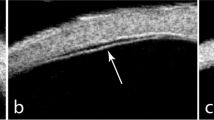Abstract
Purpose
To review the outcomes of 23-gauge transconjunctival vitrectomy in patients with postoperative endophthalmitis.
Methods
Non-randomized, interventional case series of patients with postoperative endophthalmitis over a 1-year period.
Results
23-gauge transconjunctival vitrectomy was performed on 6 patients with a mean age of 67.7 years without intraoperative or postoperative complications. There were no cases of postoperative hypotony or wound leak. The mean change in IOP was −4.2 mmHg compared to the preoperative IOP (P=0.239). Final VA improved significantly compared to preoperative VA (P=0.062), with VA of at least 20/40 in 5 of 6 patients (83.3%).
Conclusions
23-gauge transconjunctival vitrectomy is a useful technique for treating postoperative endophthalmitis.
Similar content being viewed by others
Introduction
The advantages of 23-gauge sutureless transconjunctival vitrectomy compared to conventional 20-gauge vitrectomy are shorter surgical1, 2, 3 and recovery time,1, 4 and less postoperative discomfort.1 We reviewed the outcome of 23-gauge transconjunctival vitrectomy in patients with postoperative endophthalmitis.
Case report
Over a 1-year period, vitrectomy was performed on six patients (four acute and two chronic endophthalmitis) (Table 1). The mean surgical and follow-up duration were 58.3 min (range: 40–75) and 13.2 months (range: 9–17) respectively.
In all surgeries, thorough clearance of the vitreous base was achieved. Common findings on the first postoperative day were corneal oedema, conjunctival injection, and subconjunctival haemorrhage. No patient experienced severe pain, postoperative hypotony, or wound leak. The mean intraocular pressure (IOP) on the first postoperative day was 17.3 mmHg (SD±3.4, range: 12–21 mmHg), with a mean change of −4.2 mmHg compared to the preoperative IOP (P=0.239). There were no cases of prolonged postoperative inflammation, or complications such as retinal detachment or macular hole formation.
Final visual acuity (VA) was significantly improved compared to preoperative VA (P=0.026), and was 20/40 or better in 5 of 6 patients (83.3%) overall and 3 of 4 patients (75%) with acute endophthalmitis.
Comment
Our study demonstrates that 23-gauge transconjunctival vitrectomy can be performed safely for both acute and chronic endophthalmitis. Postoperative-wound leak and hypotony have been reported with 25- and 23-gauge transconjunctival vitrectomy systems1, 2, 3, 4, 5 and may be associated with the removal of peripheral vitreous gel.1 No patient in our series developed hypotony or subconjunctival bleb formation after surgery.
Increased flexibility of 25-gauge instruments may make complex surgeries more challenging since torsion of the eye is more difficult.1 With 23-gauge vitrectomy, we were able to indent the eye and clear the vitreous base thoroughly without difficulty.
Visual acuity improved significantly in our patients, with results similar to or better than that reported in reports of elective vitrectomies using 25-gauge systems.3, 4, 5 The poor VA of patient 3 was due to pre-existing glaucoma and macular pucker.
In conclusion, 23-gauge transconjunctival vitrectomy can be performed safely in patients with postoperative endophthalmitis with no complications or hypotony, and good final VA.
References
Chen E . 25-Gauge transconjunctival sutureless vitrectomy. Curr Opin Ophthalmol 2007; 18: 188–193.
Fine HF, Iranmanesh R, Iturralde D, Spaide RF . Outcomes of 77 consecutive cases of 23-gauge transconjunctival vitrectomy surgery for posterior segment disease. Ophthalmology 2007; 114: 1197–1200.
Oshima Y, Ohji M, Tano Y . Surgical outcomes of 25-gauge transconjunctival vitrectomy combined with cataract surgery for vitreoretinal diseases. Ann Acad Med Singapore 2006; 35: 175–180.
Lakhanpal RR, Humayun MS, de Juan Jr E, Lim JI, Chong LP, Chang TS et al. Outcomes of 140 consecutive cases of 25-gauge transconjunctival surgery for posterior segment disease. Ophthalmology 2005; 112: 817–824.
Byeon SH, Chu YK, Lee SC, Koh HJ, Kim SS, Kwon OW . Problems associated with the 25-gauge transconjunctival sutureless vitrectomy system during and after surgery. Ophthalmologica 2006; 220: 259–265.
Acknowledgements
We have not received any financial support in the conduct of this research and do not have any financial or proprietary interest in the subject discussed.
Author information
Authors and Affiliations
Corresponding author
Rights and permissions
About this article
Cite this article
Tan, C., Wong, HK., Yang, F. et al. Outcome of 23-gauge sutureless transconjunctival vitrectomy for endophthalmitis. Eye 22, 150–151 (2008). https://doi.org/10.1038/sj.eye.6702987
Received:
Accepted:
Published:
Issue Date:
DOI: https://doi.org/10.1038/sj.eye.6702987
Keywords
This article is cited by
-
Acute postoperative endophthalmitis after cataract operation: result of early vitrectomy within 24 hours of presentation
Eye (2023)
-
Prompt 27-gauge sutureless transconjunctival vitrectomy for bleb-associated endophthalmitis
International Ophthalmology (2018)
-
Comparison of postoperative intraocular pressure changes between 23-gauge transconjunctival sutureless vitrectomy and conventional 20-gauge vitrectomy
Eye (2012)
-
23-gauge transconjunctival sutureless vitrectomy in treatment of post-operative endophthalmitis
Graefe's Archive for Clinical and Experimental Ophthalmology (2012)
-
Visual outcome and complications of 25-gauge vitrectomy for rhegmatogenous retinal detachment; 84 consecutive cases
Eye (2010)



